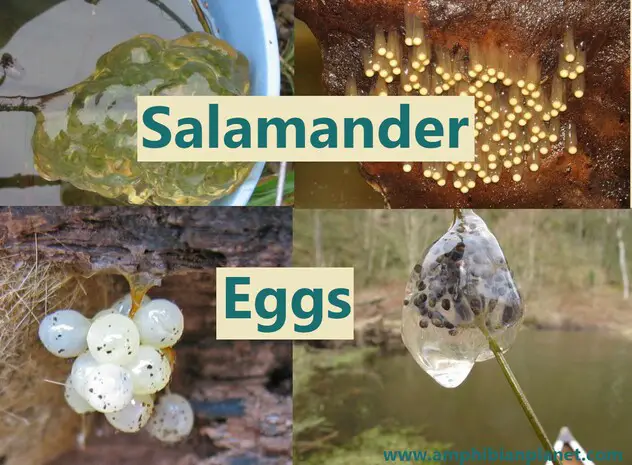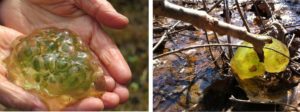There are over 600 salamander species around the world. Most of these salamanders reproduce by laying eggs, usually in the water, but some species lay their eggs on land. There are salamander species lay as few as 6 eggs, but others can lay over 300 eggs in one breeding season!
Some salamander species such as the alpine salamander do not lay any eggs. Instead, the embryos then develop inside their eggs’ inside the mother salamander’s body and hatch just before birth. In this way, these salamanders give birth to live young.
Learning about salamander eggs is great to add to your knowledge and feed your curiosity. Read on to find out everything you need to know about salamander eggs including some really interesting facts, as well as how to easily identify them.
When Is the Breeding Season of Salamanders?
The breeding season of most salamander species in the US is in the springtime from April to June when the conditions are wet and warm. However, the breeding period will vary depending on the species of salamander. Some salamander species may breed in the fall, in late summer, or even in the winter.
Salamanders that breed in the spring will typically migrate to their breeding sites in early spring, just after they emerge from hibernation. This is usually before the snow is completely gone and when pools are still partly frozen.
Here is a table that shows the breeding season of 23 salamander species.
| Salamander Species | Breeding Season |
| Tiger salamander | Spring |
| Spotted salamander | Spring |
| Marbled salamander | Late summer through early autumn |
| Blue-spotted salamander | Spring |
| Red salamander | Spring but continues through autumn |
| Long-toed salamander | Spring |
| Two-lined salamander | Autumn but continues through spring |
| Jefferson salamander | Spring |
| Northwestern salamander | Spring |
| Red-backed salamander | Late autumn but continues through spring |
| Slender salamanders | Autumn |
| Arboreal salamander | Late spring to early summer |
| Slimy salamanders | Spring but sometimes continues to very late summer |
| Mud salamander | Spring but continues to very late autumn |
| Dusky salamanders | Spring but continues through autumn |
| Spring salamander | Spring |
| Four-toed salamander | Autumn but continues through spring |
| Long-tailed salamander | Autumn but continues through early spring |
| Green salamander | Late spring but continues through early autumn |
| Cave salamander | Summer but continues through autumn |
| Small-mouthed salamander | Spring |
| Streamside salamander | Winter through early spring |
Some salamander species such as the red and the red-backed salamander are capable of storing sperm for a long period after mating before laying their eggs. This sperm is stored in special storage glands called spermatheca on the roof of the cloaca.
The females will then wait until the environmental conditions are suitable for them to lay their eggs, which is typically in the spring or the autumn.
Where Do Salamanders Lay Their Eggs?
Salamanders lay their eggs either in the water or in moist protected environments on land. Most salamander species will lay their eggs in the water or very close to water. However, others will lay eggs in rotting logs on land or in moist leaf debris.
Most Salamanders Lay Eggs in the Water
This could be in ponds, lake edges, slow-moving streams, roadside ditches, or even deep tire tracks, but the majority of salamanders very strongly prefer to breed in something called “vernal pools“.
Vernal pools are seasonal pools of water. They are formed when depressions on the ground are filled with water from melting snow and falling rain.

Since they are temporal, they do have fish that could eat the salamander eggs before they hatch, which makes them ideal breeding sites.
The female salamander will fertilize her eggs internally and lay egg masses and attach them to submerged vegetation or on the underside of submerged rocks in the pool.
This is often just a few inches below the water’s surface, but occasionally deeper.
If the pool has lots of emergent vegetation, eggs are often deposited in open areas which receive lots of sunlight.
Some Salamanders Lay Their Eggs on Land
Some salamanders, such as the slimy salamanders and the red-backed salamander lay their eggs on land, rather than in the water.
This could be in moist soil, in damp rotting logs, underneath leaf litter, in caves and rock crevices, or on the underside of rocks.
Arboreal salamanders (a type of tree climbing salamander) are even known to lay eggs high up in the forest canopy.
Marbled Salamanders Lay “Aquatic Eggs” in Dried-up Pools
Marbled salamanders have unusual reproductive behavior; instead of laying eggs in the water, they lay “aquatic” eggs on land.
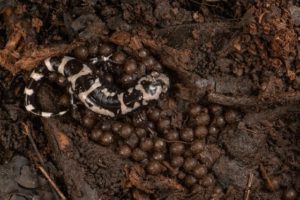
These eggs are typically laid in dried-up pools, usually under logs or leaf litter. The female will remain with her eggs to keep them moist until the autumn rain comes and fills the pool up with water.
Once submerged, tiny larvae will hatch from the eggs and live an aquatic life until they metamorphose into terrestrial juvenile salamanders.
Here is a table that shows where 23 salamander species will lay their eggs.
| Salamander Species | Where They Lay Their Eggs |
| Tiger salamander | In water |
| Spotted salamander | In water |
| Blue-spotted salamander | In water |
| Northwestern salamander | In water |
| Marbled salamander | In dried-up pools on land, that will fill with water |
| Red salamander | In water |
| Long-toed salamander | In water |
| Two-lined salamander | In water |
| Jefferson salamander | In water |
| Red-backed salamander | On land |
| Slender salamander | On land |
| Arboreal salamander | On land |
| Slimy salamander | On land |
| Mud salamander | On land near water |
| Dusky salamanders | On land near water |
| Spring salamander | In water |
| Four-toed salamander | On land near water |
| Long-tailed salamander | In water |
| Green salamander | On land |
| Cave salamander | In water found in caves |
| Small-mouthed salamander | In water |
| Streamside salamander | In water |
How Many Eggs Do Salamanders Lay?
Salamanders lay anywhere from 6 to as many as 500 eggs in a single breeding season, depending on the species.
These eggs are usually laid in masses, but some species lay eggs singly. Salamanders that lay eggs on land tend to lay fewer eggs than those that lay eggs in the water, but this is not always the case.
Here is a table that shows approximately how many eggs 22 salamander species lay.
| Salamander Species | How Many Eggs They Lay |
| Tiger salamander | 50- 100 |
| Spotted salamander | 100 – 300 |
| Blue-spotted salamander | 300 – 500 |
| Northwestern salamander | 30 – 270 |
| Marbled salamander | 30 – 200 |
| Red salamander | 29 – 130 |
| Long-toed salamander | 200 – 400 |
| Two-lined salamander | 25 – 50 |
| Jefferson salamander | 30 – 200 |
| Red-backed salamander | 3 – 17 |
| Slender salamander | 4 – 11 |
| Arboreal salamander | 12 – 24 |
| Slimy salamander | 6 – 36 |
| Mud salamander | 65 – 200 |
| Dusky salamanders | 9 – 34 |
| Spring salamander | 16 – 160 |
| Four-toed salamander | 18 – 41 |
| Long-tailed salamander | 60 – 110 |
| Green salamander | 10 – 32 |
| Cave salamander | 50 – 120 |
| Small-mouthed salamander | 300 – 800 |
| Streamside salamander | 50 – 130 |
Do Mother Salamanders Care For Their Eggs?
Only 18% of all salamander species care for their eggs. In some salamander species, such as the dusky salamander, the females stay with their eggs to care for them and protect them from predators until they hatch.
However, other salamander species such as the spotted salamander abandon their eggs right after laying them.
A few salamander species that care for their eggs after laying are:
- Dusky salamanders
- Red-backed salamander
- Slimy salamander
- Marbled salamanders
- Two-lined salamanders
- Long-tailed salamander
- Spring salamander
- Shovel-nosed Salamander
- Mud salamander
- Arboreal salamander
How Long Does It Take for Salamander Eggs to Hatch?
The eggs laid by most salamander species will hatch after about three to six weeks. However, this will vary depending on the specific species, and the environmental conditions. Some salamander eggs may hatch after only a week, while others may take up to two months before they hatch.
Here are salamander eggs that are close to hatching:
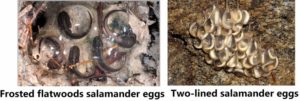
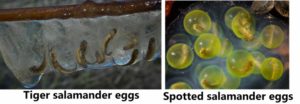
If the environmental temperatures and warm and the humidity levels are high, the eggs will typically develop and hatch faster.
Do Salamanders Take Care of Their Babies?
No, salamanders do not give parental care to their offspring. In salamanders that offer parental care, the care is limited to protecting the eggs before they hatch. Once the eggs hatch, the salamander will typically abandon them.
However, newly hatched salamanders may receive some parental protection if they remain in the nest or egg deposition site for a brief period, but the care will end once they leave the nest to begin feeding.
What Salamander Eggs Look Like
When aquatic salamander eggs (eggs laid in the water) are laid, they are embedded in special secretions from a gland in the salamander’s body.
These secretions combine with water to create a jelly-like coating around the entire egg mass. The thickness of this jelly layer will vary dramatically depending on the species.
The jelly is usually clear or cloudy white but can be slightly different colors depending on the salamander species. It can be brown, cream-colored, or even have a bright green glow from algae.
The jelly protects the eggs from drying out if the water level in the pool drops. It also protects them from predators such as frogs or newts.
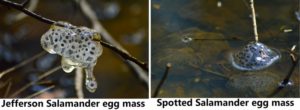


Sometimes, salamander eggs are laid singly rather than in masses.
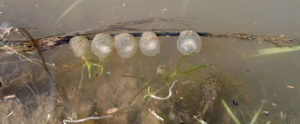
Some salamander egg masses, most notably those of the spotted salamander may become green with algae.

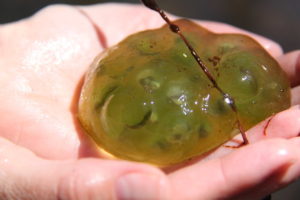
What Terrestrial Salamander Eggs Look Like
Unlike salamander eggs laid in the water, salamander eggs laid on land do not have a layer of jelly surrounding the egg mass.
Instead, the individual eggs have soft egg sacks to protect them from the elements and are sometimes covered in slime.


Check out this post to get more detailed information on what both aquatic and terrestrial salamander eggs look like.
What Are the Differences Between Salamander Eggs and Eggs of Other Amphibians?
Amphibian eggs, particularly those laid in the water can be difficult to tell apart unless you have a close eye to watch for differences.
Here is how you can differentiate salamander eggs from those of other amphibians.
Salamander Eggs vs Frog Eggs
The easiest way to tell the difference between salamander eggs from frog eggs is to look at the outer layer of the egg mass.
Salamander egg masses are covered in an outer layer of jelly, while frog masses are not.
If you took a close look at a frog egg mass, you would easily notice the contour of each individual egg outside of the egg mass.

On the other hand, if you took a close look at a salamander egg mass, you would not see any contour since the entire mass is covered by an outer jelly coat.

Also, salamander eggs tend to hold together better than frog eggs. If you were to pick up a salamander egg mass, it would hold its shape even out of water.
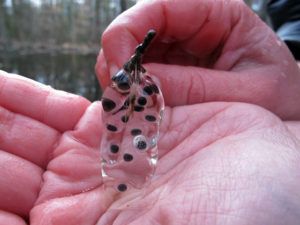
However, if you picked up a frog egg mass, it would be looser and the eggs would fall apart more easily and may even “drip” off your hand
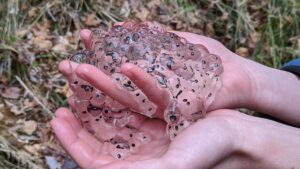
Here is what the eggs of a Jefferson salamander look like next to those of a wood frog.
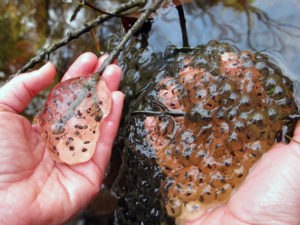
Salamander Eggs vs Toads Eggs
Telling the difference between salamander eggs and toad eggs is fairly easy.
Toad egg masses are laid in long strings (one to three eggs wide) along plants or on the bottoms of shallow water in ponds. The eggs are covered in jelly and look almost like a jelly-coated necklace. Salamander eggs are laid in masses or individually, but never in strings.
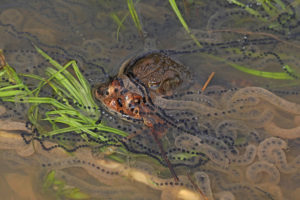

Toad egg strands sometimes have a coiled pattern and may have a double envelope surrounding eggs.
Salamander Eggs vs Newt Eggs
Salamanders are often informally divided into two groups: “Newts” and “true salamanders”. Salamanders typically have smooth moist skin while newts tend to have more rough, grainy skin.
In simple terms, newts are a specific type of salamander, kind of like “a species within a species”.
Unlike most “true salamanders”, most newts do not lay their eggs in masses. Rather, female newts lay eggs singly and wrap each egg with the leaf of a pond plant using their back legs.
They do this to protect the eggs from predators, such as frogs, or even other newts.
However, some newts such as the California newt lay eggs in masses rather than singly. The egg masses are covered in an outer layer of jelly, kind of similar to how most “true salamanders” lay their eggs.
Newt eggs laid in masses are nearly identical to those of true salamanders and can be hard for the untrained eye to distinguish.

Newt eggs laid singly are easiest to distinguish from those of salamanders:
Newt eggs are laid singly and wrapped in the leaf of a pond plant, salamander eggs laid singly are laid along the same stick, but are never wrapped in the leaf of a pond plant.


Apart from this difference, newt eggs can be difficult to distinguish from salamander eggs.
The Eggs of Aquatic Salamanders Are a Little Different
Aquatic salamanders live entirely in the water, so their eggs and breeding process are a little from those of terrestrial salamanders.
Hellbenders
In hellbenders, the male will excavate a nest under a rock or log, and guide the female into his nest to lay her eggs.
As the female begins to deposit her eggs, the male simultaneously releases sperm to fertilize the eggs externally, very similar to how most frogs fertilize their eggs.

A single female can lay anywhere from 100 to as many as 300 eggs in a single breeding season. Once the egg laying is complete, the male will remain in the nest to protect the eggs from predators until they hatch.
Axolotls
Axolotls mate in the same way that most salamanders do. The male releases a spermatophore and the female picks it up to fertilize her eggs internally. When laid, the eggs are attached to submerged twigs or other vegetation.
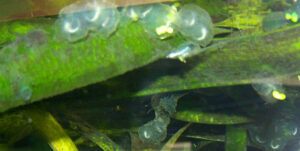
Mudpuppies
Mudpuppies are slightly different in that they excavate nests, very similarly to hellbenders. After internal egg fertilization, the female will turn upside down and attach her eggs to the bottom of the rock (or log) over her nest.
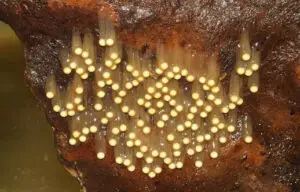
However, unlike hellbenders, it is the female mudpuppy rather than the male who remains to defend the eggs from predators.
Sirens
Sirens mate in spring and will lay anywhere from 12 to 300 eggs at the bottom of the water, usually among plant roots and surrounded by vegetation.
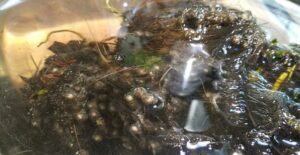
Since very little research has been done into the reproduction of these salamanders, not much is known about their mating behavior.
However, it is assumed to be violent because bite marks have been found, mostly on females during the mating season.
This assumption has been challenged because biting has also been observed out of the mating season.
What Animals Prey on Salamander Eggs?
Since most salamanders abandon their eggs soon after laying, their eggs are preyed on by a variety of animals. Newts, crayfish, fish, frogs, large salamander larvae, and even other salamanders are all known to eat salamander eggs.
Once the eggs hatch, the larvae are preyed on by aquatic insects & aquatic insect larvae (such as dragonfly larvae), snakes, turtles, newts, and larger salamander larvae.
Salamander eggs (and larvae) are vulnerable to almost any type of predator – for this reason, it is estimated that 90% of all spotted salamander eggs are wiped out by predators before they can hatch.
What to Do if You Find Salamander Eggs
If you live near a wooded area, especially near a stream, pond, or another water body there’s a chance of encountering salamander eggs in the spring. If this happens, be sure to avoid disturbing the eggs.
Disturbing or removing the eggs from the water could damage them, or even kill the tiny embryos developing inside the eggs.
Even terrestrial salamander eggs (those laid on land) can easily be damaged if you move or disturb them.
If you discover terrestrial salamander eggs while moving around leaf litter, mulch, or logs, gently put the debris back onto the eggs without disturbing them. The mother knew what she was doing when she laid them in that spot.
If you find aquatic salamander eggs out of the water, it is best to leave them alone, especially if they are very near the water.
However, if you find aquatic salamander eggs that were disturbed (by a human or animal) and taken out of the water, you could try to put them back in the water.
If the egg mass is still attached to a stick, very gently put the stick back in the water (just a few inches below the surface).
Still, the eggs are not guaranteed to hatch because the disturbance may have damaged them or killed the embryos developing inside.
Of course, there’s no harm in observing the eggs from a distance.
Can You Care for Salamander Eggs?
You should never take salamander eggs out of the wild. However, if you have captive salamanders that happen to lay eggs, taking care of the eggs should be fairly easy.
If you live in an area within the natural range of that particular salamander species, the eggs can be cared for and hatched outdoors (during the normal breeding season of that particular salamander).
Construct a pool about 8 feet by 12 feet utilizing wooden or concrete walls sunken into the ground to a depth of about 10 inches. Place lots of sand and natural forest debris into the pool to simulate a natural pond bottom.
Fill the pool with water; however, not just any water will do. Tap water should not be used as it could contain chemicals like fluoride and chlorine that will be harmful to the eggs.
Place the eggs in the pool and remember to watch pool water levels and monitor the eggs to ensure the embryos are developing properly.
Once the eggs hatch, you can start feeding the larvae (baby salamanders) on the second or third day. Before that, the leftover nutrients from the eggs will meet all their energy requirements.
Things Mistaken for Salamander Eggs
if you saw a jelly-like mass attached to submerged tree branches and other vegetation, you would probably think it’s a salamander egg mass. But this is not always the case. Sometimes, it could just be a bryozoa colony.
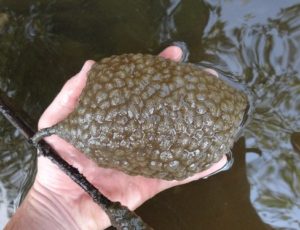
Bryozoans are microscopic aquatic animals similar, but not related, to corals. Their name literally means “moss animal”.
Bryozoans are fairly common in lakes, streams, and other water bodies, and form jelly-like colonies attached to rocks or submerged branches.
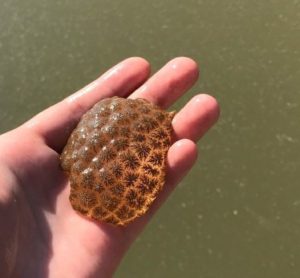
The colonies are firm and have weird crusty-looking things on the outside, but never have embryos on the inside. Many people confuse bryozoa colonies for salamander eggs, but now you know better.

Do All Salamanders Lay Eggs?
Although most salamanders lay eggs, a few species, such as the fire and alpine salamander do not lay eggs as most salamanders do. Rather, they give birth to live young.

These salamanders mate on land and fertilize their eggs internally, just like the fully terrestrial egg-laying salamanders. The embryos then develop inside their eggs’ inside the mother salamander’s body and hatch just before birth. This is known as “ovoviviparity“.
To give birth, a female fire salamander will crawl backward and immerse her cloaca in shallow, usually slow-moving water. She then releases about 15 to 70 well-developed aquatic larvae, but this number can vary depending on the subspecies.
However, alpine salamanders and Salamandra s. bernardez (a subspecies of fire salamander) are unique because they give birth to fully-developed juveniles who live a fully terrestrial life from the moment of their birth.
In these salamanders, an embryo develops from the first egg in each uterus. The embryo then feeds on the yolk of the other eggs which provide enough nutrition to sustain the developing embryo until it is ready to be born.
Pregnancy can last 2-3 years and the female salamander will give birth in a damp protected environment to keep the newborns safe from predators.
Some Salamanders Can Reproduce Asexually
Although most salamanders reproduce via sexual reproduction, a few salamander species such as the silvery salamander can reproduce asexually using a form of parthenogenesis called ‘kleptogenesis‘.
In these salamanders, the females steal sperm from closely related salamander species. However, the sperm isn’t to fertilize the eggs’, rather, it induces the eggs to develop independently.
The result is that the offspring are exact clones of their mothers without the contribution of genetic material from sperm. Also, the offspring are all female.
Frequently Asked Questions:
Do salamanders eat their own eggs? Salamanders are known to eat many of their own and other salamander’s eggs. Some salamander species, such as the hellbender will sometimes eat more than half of their own eggs.
How do salamanders move their eggs? Salamanders do not move their eggs once they are laid. The eggs are typically attached to a stick, rock, or other surface and will stay there until they hatch.
What do salamander eggs need to survive? Water quality, temperature, and humidity levels are the most important factors that determine whether or not salamander eggs will survive and hatch.
If the temperatures rise too high or drop too low, tiny embryos developing inside the salamander eggs could die.
If the water quality is poor, the eggs could die. Also, if the humidity levels in the environment drop too low, the eggs could dry out and die.
How Much Do You Know About Salamander Eggs?
If you are interested in testing out your new knowledge on salamander eggs, act quickly in the spring. The eggs usually only remain for a few weeks and the embryos develop rapidly.
If you arrive at a known breeding pond looking for egg masses but do not see any; carefully look at the bottom of the pool. If you see tiny white cones that look like specks of paint (spermatophores), you are too early.
Give it a night or two and you will most likely find egg masses when you return.

